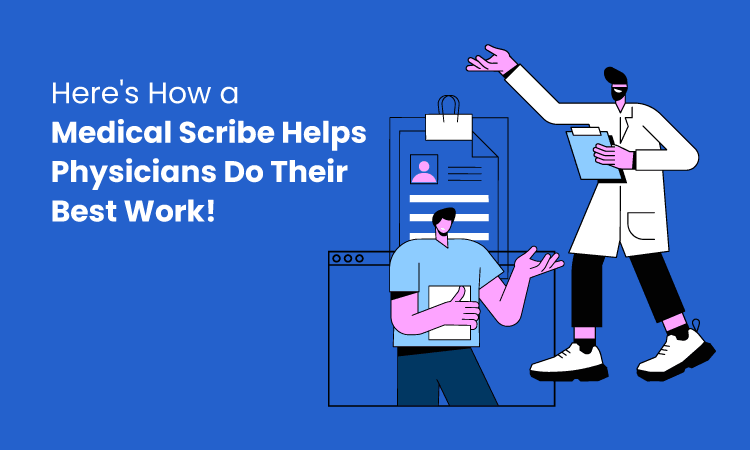For the most part, medical facilities managers and owners know the basics of how a medical scribe helps the physician become more efficient. However, scribes are a relatively new addition to healthcare. So, many managers or owners could learn more about how to maximize a medical scribe.
A medical scribe is a trained individual who documents patient encounters in real-time in a clinical setting, allowing the healthcare provider to focus on the patient and improve the efficiency and accuracy of the encounter; they also assist with chart review and other administrative tasks.
Having a medical scribe can be beneficial as it allows healthcare providers to focus on the patient during the encounter rather than on documenting it. Physicians may also assign other administrative tasks to a medical scribe–that's what we will focus on in this article!
How a Medical Scribe Helps the Physician with Daily Tasks
A doctor spends around 40-80 hours per week at work. These hours include time spent in patient care, administrative tasks, and continuing education. However, the number can vary depending on the specialty and practice setting.
Additionally, many physicians spend extra time on paperwork and administrative tasks outside their official work hours.
With this in mind, it's easy to see why a medical scribe would be very helpful to doctors and healthcare practitioners. When a physician has a scribe, they can delegate the following tasks:

How Scribes Assist in Charting Patient Information
Charting patient information involves documenting a patient's health history, symptoms, and treatment in a medical record. This process typically begins with the patient's initial visit. The healthcare provider will take a detailed medical history, perform a physical examination, and record any relevant findings in the patient's chart.
As the patient receives further care, the healthcare provider will continue documenting changes in the patient's condition, including symptoms, test results, and treatment plans.
This information is typically recorded in a structured format that includes headings for different types of information, such as demographics, medical history, and progress notes. The healthcare provider must be thorough and accurate when charting patient information as it is used for continuity of care and billing purposes.
How A Medical Scribe Helps the Physician with Patient Exams
During patient exams, the physician's role includes the following:
- Preparing the patient for examination.
- Conducting the examination.
- Taking notes during the examination.
Preparing the patient for examination typically involves explaining the examination process, answering any questions the patient may have, and obtaining informed consent.
During the examination, the physician will typically take a detailed history, perform a physical exam, and may order diagnostic tests as needed. The physician will take notes during the examination, documenting the patient's symptoms, vital signs, examination findings, and diagnostic test results.
The physician may also make a preliminary diagnosis and develop a treatment plan during the examination. Physicians must be thorough and accurate in their notes to ensure continuity of care.
How Scribes Help Order Lab Tests and Imaging Studies
A physician can have their scribe enter the orders for imaging or lab tests into the electronic medical record (EMR). They may also relay the necessary preparations the patient must do before the test and any other relevant information. The medical scribe can then review the order and ensure it is complete and accurate before submitting it to the lab or imaging center.
The physician can also assign the medical scribe to follow up on the results once they are available, monitor them for developments, and document them in the EMR. This delegation allows the physician to focus on other tasks, such as reassuring the patient, performing the exam, and making an accurate diagnosis.
How a Scribe Coordinates with Other Healthcare Professionals
A physician can delegate coordinating patient care with nurses and other staff to a medical scribe. The scribe can also review the patient's care plan and communicate any changes or updates to the appropriate healthcare staff.
The doctor may delegate coordination with other physicians and specialists to a medical scribe. They can then make the necessary calls, emails, or faxes to other healthcare professionals on the patient's behalf. It can also fall on the scribe to follow up with other specialists to ensure that crucial developments are in the EMR.
How Scribes Assist in Scheduling Appointments
A medical scribe can handle scheduling appointments by working closely with the physician and other healthcare staff to ensure that patients receive timely and appropriate care. They can manage the physician's schedule and make appointments convenient and efficient for the physician and the patient.
Scheduling management can include follow-up appointments, coordinating with other healthcare providers, and managing cancellations and rescheduling. The scribe ensures that all arrangements are in the electronic medical record (EMR) and that patients know their upcoming appointments by phone or automated systems.
The scribe also assists with scheduling any necessary diagnostic tests or procedures in coordination with the physician's orders and makes sure the patient is aware of the details of the appointment and any necessary preparation.
How Scribes Handle Billing, Insurance, and Coding
Doctors can also assign scribes to input insurance information, and the scribe may assist in preparing claims and submitting them to the insurance company or government payer. They can also assist in verifying insurance coverage and ensuring that the patient's insurance information is up to date.
In addition, the scribe can review billing codes. They can cross-check the procedures and diagnoses in the EMR for accuracy. They can also handle any insurance or billing-related questions or issues that may arise and follow up with insurance companies or government payers to ensure that claims are processed and paid promptly.
Benefits of Having A Medical Scribe
A medical scribe offers plenty of benefits to a healthcare team or department. Here are just some of them!

How Scribes Help Enhance Patient Satisfaction
Using scribes can enhance patient satisfaction. With a medical scribe handling the documentation, physicians can focus on interacting with patients, leading to a more positive patient experience. Additionally, medical writers can improve the accuracy and completeness of medical records, leading to better patient outcomes and satisfaction.
How a Medical Scribe Helps the Physician Increase Revenue
A medical scribe can also increase revenue by allowing physicians to see more patients. Medical scribes can handle tasks such as scheduling appointments, which can free up physicians' time. Furthermore, scribes can improve billing and coding accuracy, leading to more accurate claims submissions and, therefore, more revenue.
Why a Scribe Enhances a Physician's Job Satisfaction
Finally, having a medical scribe can also enhance a physician's job satisfaction. Medical scribes can reduce the burden of documentation, which can be frustrating for many physicians. Additionally, medical writers allow physicians to focus on what they enjoy most, patient care, which leads to more job satisfaction.
In Summary: A Medical Scribe Helps Physicians Do Better Work
A medical scribe is a valuable member of the healthcare team. The medical scribe helps the physician in many ways by taking care of documentation, coordination, and administrative tasks, which leads to improved patient care, physician satisfaction, and revenue.
Hire a medical scribe through Wing Assistant. Wing is a premier remote assistant service matching healthcare facilities with managed, dedicated remote scribes. Get in touch with us today to learn more!
Aya is Wing Assistant’s blog manager. When she’s not wrangling content briefs, editing article drafts and handling on-page SEO, she is crafting messages for Wing’s other communication materials. Aya writes about SaaS startups, marketing for startups, search engine optimization, and pop culture.







